| Article ID | Journal | Published Year | Pages | File Type |
|---|---|---|---|---|
| 1978317 | Comparative Biochemistry and Physiology Part C: Toxicology & Pharmacology | 2006 | 10 Pages |
The age-related difference in fluoroquinolone-induced tendon toxicity was investigated.In vitro tendon cells from juvenile and young adult rabbits, respectively, were incubated with quinolone (nalidixic acid, NA) or fluoroquinolone (ofloxacin, OFX or pefloxacin, PEF) at 0.01 μM to 1 mM for 72 h. Redox status, glutathione (GSH), reactive oxygen species (ROS), and mitochondrial activity were assessed using intracellular fluorescent probes. Fluorescence signal was detected on living adherent tenocytes in microplates using cold-light cytofluorometry. Tendon toxicity differed significantly between the two cell groups and the difference was greatest with highest dose (1 mM). For 72 h, significant (p < 0.001) differences between immature and young adult primary tenocytes were observed for redox status decrease, GSH decrease, and ROS production increase. Mitochondrial activity remained unaltered in immature tenocytes. We confirm two groups of intrinsic tendon toxicity (OFX/NA vs. PEF) associated to oxidative stress (GSH decrease). Our in vitro experimental model confirms the clinical observations of age dependent tenotoxicity. First group (NA, OFX) showed greater intrinsic tenotoxicity for young adult than immature tenocytes, second group (PEF) was highly toxic for immature and young adult cells. The three quinolones do not altered mitochondrial activity in immature tenocytes whereas alteration was observed in young adult tenocytes.
